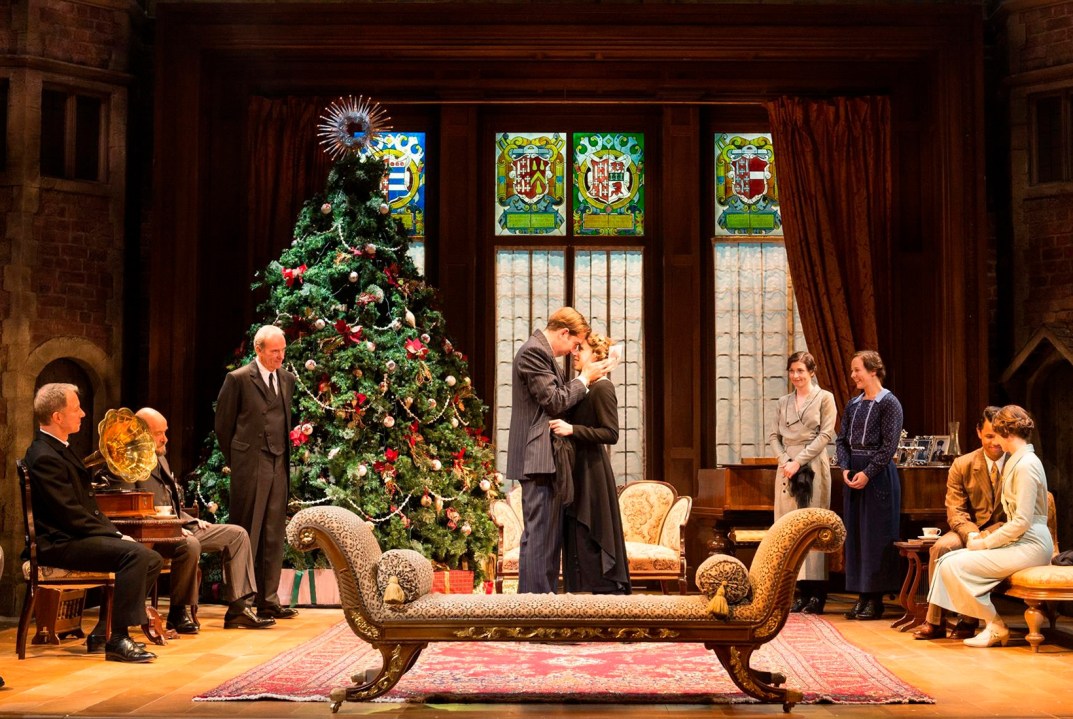The RSC’s 2014 version of Much Ado is breathtaking to look at. Sets, lighting and costumes are exquisitely done, even if the location is not established with absolute clarity. The date is Christmas 1918 and we’re in a stately home that has been converted into a billet, or a hospital, for returning soldiers. The prickly Beatrice (Michelle Terry) seems to be an unemployed aristocrat working as a volunteer nurse. She fusses around the ward making discreet enquiries about an old flame, Benedick, whose memory she can’t shake off. Enter Benedick played by Edward Bennett and the fun starts. These two absolutely get inside the skins of their characters. Terry’s portrait of spiky seductiveness is riveting to watch and Bennett has an amazing range of effects at his disposal. He’s graceful, confident, easy-going and slightly goofy with it. Warmth oozes from him. He may lack the classic good looks of a leading man but he somehow evokes the shade of Cary Grant. He’s one of our most underused actors.
Not even a genius could make Shakespeare’s Dogberry scenes funny
Director Christopher Luscombe has invented some wonderful physical comedy involving a Christmas tree and a snaffled glass of whisky. But not even a genius could make the Dogberry scenes funny. When people claim that Shakespeare couldn’t write comedy they cite the watchmen in Much Ado. Not only do these bungling fools have no amusing lines but their scenes go on far too long without reaching a climax. Nick Haverson has the thankless task of playing Dogberry as an unlettered London bobbie. Doubtless Shakespeare and his audiences were amused by ill-educated characters and their verbal blunders (confusing ‘execute’ with ‘interrogate’), but nowadays we call this failing illiteracy or dyslexia and we regard it as a cause for sympathy and treatment rather than mockery.
Charlie Ward at Home also has a first world war setting. Originally this was an immersive theatrical show based on an experimental therapy for wounded soldiers. The injured men were entertained in their beds by Chaplin movies projected on to the ceiling. Viewers may sample this experience online. First they have to negotiate the detailed instructions. ‘Watch the piece lying in a quiet room made as dark as possible.’ Headphones are suggested. Spectators with the right equipment are advised ‘to connect your device to a projector’ and beam it on to an overhead screen.
The show opens with a Chaplin short from 1915, By the Sea, in which the little tramp visits a beach and gets into fights with strangers over ice creams and hats. It’s good, if not classic Chaplin. Film buffs believe this is the first movie in which Charlie slips on a banana skin. Then the movie halts. The screen goes blank and a female voice starts to talk about milk, butterflies and anemones. The film resumes and then cuts out again. The female voice addresses a character, Harry, who seems to be a hospitalised soldier. Delirious recollections from his childhood are relayed by the female who turns out to be his mother. Harry grows up, attends a firework party, in Germany it seems, and later he receives a letter from his mother while serving at the front. She alludes to the noise of artillery which she can dimly hear across the Channel. This explains why a Chaplin movie with a beach location has been chosen. The sea provides a link between Chaplin and the war. This is pretty tenuous stuff. The show is frustrating to watch and more than a little pretentious. Many will conclude that By the Sea (available on YouTube) is best enjoyed without interference from later dabblers.
The Lord Chamberlain’s Men recreate Shakespeare in a form very close to the original. Their dressing-up box is crammed with breeches, tights, buckles and tunics. The female characters, played by men, wear floor-length Elizabethan gowns with complex drawstrings at the front. Their version of The Tempest, from 2018, stars Danann McAleer as a forlorn, bearded Prospero. He sobs out every line as if drawing on some fathomless well of sorrow. Ronnie Yorke has a pleasantly distracted air as Ferdinand and he conveys his love for Simon Jenkins (Miranda) with complete sincerity. Reece Richardson is a filthy, grunting caveman of a Caliban. Plastered in mud, he crouches low and roars out his lines like a Glastonbury hipster hunting for a lost stash of skunk. Ariel is played by William Pennington who is afflicted by a glut of supplementary talents. He sings nicely, he plays the recorder, and his ballet skills have been honed during long hours in the studio. The set includes a special flight of stairs to accommodate his footwork as he gambols up and down, performing little pirouettes and scissor kicks to accentuate Ariel’s lines. Impressive stuff, but it doesn’t quite cohere with the earthy, direct aesthetic of the production. This is a solid, no-frills show. Ideal for teens who are new to the Bard.








Comments